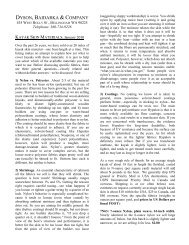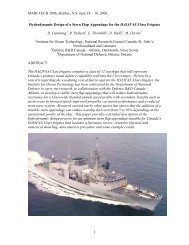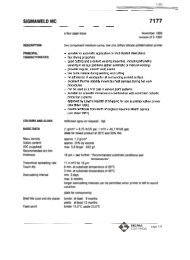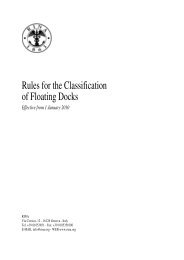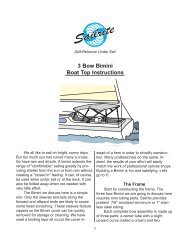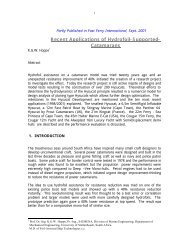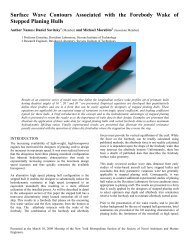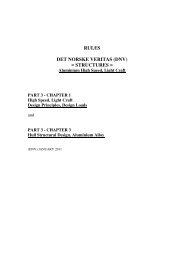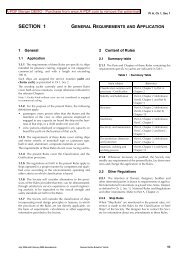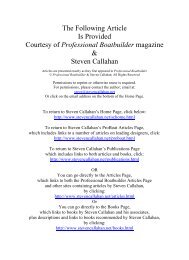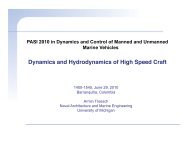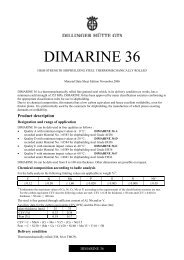Origin and Characteristics of the Spray Patterns TR-2882 3-10 ...
Origin and Characteristics of the Spray Patterns TR-2882 3-10 ...
Origin and Characteristics of the Spray Patterns TR-2882 3-10 ...
Create successful ePaper yourself
Turn your PDF publications into a flip-book with our unique Google optimized e-Paper software.
<strong>TR</strong>-<strong>2882</strong><br />
<strong>Spray</strong> <strong>Patterns</strong> for Three-Dimensional Planing Hulls<br />
Whisker <strong>Spray</strong>. As shown on Fig.6, for two-dimensional sections normal to <strong>the</strong> stagnation line, <strong>the</strong> oncoming<br />
velocity component Vn is deflected from <strong>the</strong> stagnation line <strong>and</strong> is redirected forward along <strong>the</strong> bottom at <strong>the</strong> same<br />
velocity Vn. In actual three-dimensional flow, <strong>the</strong> velocity component along <strong>the</strong> stagnation line, Vs, (in a direction<br />
from keel to chine) is added vectorially to <strong>the</strong> velocity component Vn. As shown by <strong>the</strong> dashed vectors on Fig.11, <strong>the</strong><br />
resultant velocity V <strong>the</strong>n makes an angle α relative to <strong>the</strong> stagnation line. This is exactly equal to <strong>the</strong> angle between <strong>the</strong><br />
free-stream velocity <strong>and</strong> <strong>the</strong> stagnation line. This principal that “<strong>the</strong> angle <strong>of</strong> incidence <strong>of</strong> <strong>the</strong> free stream is equal to <strong>the</strong><br />
angle <strong>of</strong> reflection <strong>of</strong> <strong>the</strong> spray relative to <strong>the</strong> stagnation line” was suggested by Pierson <strong>and</strong> Leshnover (1950).<br />
This analytical conclusion is supported by experimental data as noted in a paper by Savitsky, Delorme, <strong>and</strong> Datla<br />
(2007). They refer to flow studies along <strong>the</strong> bottom <strong>of</strong> a planing hull wherein <strong>the</strong> hull was coated with a so-called<br />
soluble “turbulence detection paint”. As shown on <strong>the</strong> photograph in Fig.12, <strong>the</strong> direction <strong>of</strong> <strong>the</strong> flow in <strong>the</strong> area<br />
forward <strong>of</strong> <strong>the</strong> stagnation line is clearly identified by streaks in <strong>the</strong> soluble bottom paint <strong>and</strong> indeed confirms that <strong>the</strong><br />
angle <strong>of</strong> reflection <strong>of</strong> <strong>the</strong> whisker spray velocity relative to <strong>the</strong> stagnation line, is equal to <strong>the</strong> angle <strong>of</strong> incidence <strong>of</strong> <strong>the</strong><br />
free stream velocity relative to <strong>the</strong> stagnation line. This experimental observation provides credibility to <strong>the</strong> approach<br />
undertaken in this study to explain <strong>the</strong> origin <strong>of</strong> <strong>the</strong> spray patterns on planing hulls. A subsequent section <strong>of</strong> this paper<br />
applies this approach to also characterize <strong>the</strong> main spray.<br />
An important characteristic <strong>of</strong> <strong>the</strong> whisker spray is that it leaves <strong>the</strong> chine at an angle that is equal to <strong>the</strong> local<br />
geometric angle <strong>of</strong> <strong>the</strong> hull bottom relative to <strong>the</strong> level water surface. For conventional combinations <strong>of</strong> trim <strong>and</strong><br />
deadrise, this hull bottom angle is relatively small <strong>and</strong>, consequently, <strong>the</strong> whisker spray, which follows a ballistic<br />
trajectory after leaving <strong>the</strong> chine, does not achieve large heights above <strong>the</strong> water surface. Fur<strong>the</strong>rmore, since <strong>the</strong><br />
whisker spray is composed <strong>of</strong> thin, light droplets <strong>of</strong> fluid it is readily deflected by <strong>the</strong> moderate alterations to <strong>the</strong> chine<br />
geometry.<br />
The length <strong>of</strong> <strong>the</strong> whisker spray, Lws, measured forward along <strong>the</strong> chine from <strong>the</strong> stagnation intersection with <strong>the</strong> chine<br />
is given by <strong>the</strong> following equation:<br />
Lws<br />
b tan β b<br />
−<br />
π tanτ<br />
2 tan(2α<br />
)<br />
= Eq. 5<br />
The leading edge <strong>of</strong> spray sheet along <strong>the</strong> bottom makes an angle, α, relative to <strong>the</strong> stagnation line <strong>and</strong> 2α relative to <strong>the</strong><br />
keel (see Fig.11). The angle α has been defined previously.<br />
Main <strong>Spray</strong> (<strong>Origin</strong> <strong>and</strong> Description). Main spray is <strong>the</strong> more important <strong>of</strong> <strong>the</strong> two distinct spray patterns shown<br />
on Fig.1 because it is more likely to impact adjacent structure <strong>and</strong> increase <strong>the</strong> resistance <strong>of</strong> <strong>the</strong> craft. Its appearance, at<br />
moderate speeds, initially resembles a continuous blister <strong>of</strong> fluid in <strong>the</strong> form <strong>of</strong> a cone whose apex is in <strong>the</strong> vicinity <strong>of</strong><br />
<strong>the</strong> stagnation line intersection with <strong>the</strong> chine. As <strong>the</strong> speed increases, <strong>the</strong> blister becomes unstable, <strong>and</strong> breaks-up into<br />
a dense distribution <strong>of</strong> droplets <strong>of</strong> water with large trajectory angles <strong>and</strong> a velocity equal to <strong>the</strong> speed <strong>of</strong> <strong>the</strong> craft. This<br />
spray <strong>of</strong> droplets becomes aerated, <strong>and</strong> when seen on full-scale planing craft has a milky-white appearance (see Fig.<br />
13). Main spray can cause structural damage <strong>and</strong> increase <strong>the</strong> hull resistance when impacting sections <strong>of</strong> <strong>the</strong> hull that<br />
are in <strong>the</strong> path <strong>of</strong> its trajectory. This is particularly evident with planing catamarans (with symmetrical hulls) <strong>and</strong> waterbased<br />
aircraft. The following discussion provides a qualitative description <strong>of</strong> <strong>the</strong> hydrodynamic flows that lead to <strong>the</strong><br />
development <strong>of</strong> <strong>the</strong> main spray.<br />
For <strong>the</strong> previously described two-dimensional planes normal to <strong>and</strong> near <strong>the</strong> chine terminus <strong>of</strong> <strong>the</strong> stagnation line, i.e.,<br />
section k 3 c 3 , a sharp change in <strong>the</strong> flow pattern takes place. This is because <strong>the</strong> effective two-dimensional section<br />
becomes a surface <strong>of</strong> finite length whose leading edge is in close vicinity to <strong>the</strong> water surface <strong>and</strong> whose flow patterns<br />
are described by Green <strong>and</strong> confirmed by <strong>the</strong> experimental results <strong>of</strong> <strong>the</strong> present study. As previously shown, both <strong>the</strong><br />
spray thickness <strong>and</strong> its trajectory angle increase rapidly for sections approaching <strong>the</strong> chine. In fact, <strong>the</strong> two dimensional<br />
velocity component <strong>of</strong> <strong>the</strong> spray, Vn, actually attains a 90 deg, trajectory angle relative to <strong>the</strong> level water surface.<br />
For <strong>the</strong> three-dimensional planing hull <strong>the</strong> Vn component <strong>of</strong> <strong>the</strong> velocity, (V sin α) is combined vectorially with <strong>the</strong><br />
velocity component Vs, (V cos α), along <strong>the</strong> stagnation line so that <strong>the</strong> resultant velocity <strong>of</strong> <strong>the</strong> outboard directed spray<br />
is equal to <strong>the</strong> free stream velocity V. Consider a plane perpendicular to <strong>the</strong> stagnation line, <strong>and</strong> recall (from Fig.9) that<br />
<strong>the</strong> circular distribution <strong>of</strong> <strong>the</strong> direction <strong>of</strong> Vn relative to <strong>the</strong> free water surface varies from a small value (trim angle) to<br />
a maximum <strong>of</strong> 90 deg. <strong>and</strong> <strong>the</strong>n decreases as <strong>the</strong> chine is approached—all this occurs within a relatively small distance<br />
5



